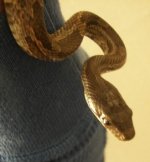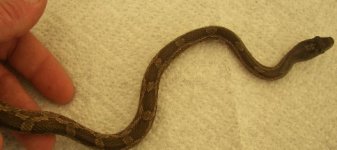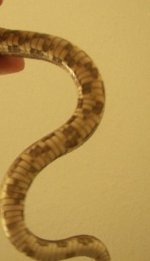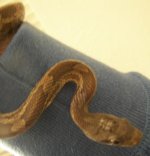I posted in another thread about the differences between Corns and rat snakes here was my question:
Ok. I get the point that corn snakes are rat snakes. Read somewhere that all corn snakes are rat snakes but not all rat snakes are corns. I get this and understand (kinda) the whole classifications thing. However, what i can't seem to find an answer to here or anywhere else I've lookedis; if corns are different from other ratsnakes, what is the physical difference and how do you tell? Kudos to anyone who answers.
I'm asking because I found a snake crawling across the floor at work yesterday and have given it a good home. I've had corns before and this looks exactly like my others just a dakrer coloration, leading me to believe it may be a rat snake. Here are some pics, you guys can tell me what you think.
Thanks!
airenlow suggested a new thread so here we are. to answer his questions from the other thread:
If it looks exactly like your corns except slightly darker then why would you assume it wasn't a corn?
Because I dont currently have another corn to campare it to so I'm going by memory, also I'm finding that there are very few differences between the appearance of a corn and a rat so it's a little difficult.
WC corns tend to be darker than CB anyways. Where do you live? Corns are native all over the south and east
I live in the Dallas, Texaas area.
Here are some pics:
Ok. I get the point that corn snakes are rat snakes. Read somewhere that all corn snakes are rat snakes but not all rat snakes are corns. I get this and understand (kinda) the whole classifications thing. However, what i can't seem to find an answer to here or anywhere else I've lookedis; if corns are different from other ratsnakes, what is the physical difference and how do you tell? Kudos to anyone who answers.
I'm asking because I found a snake crawling across the floor at work yesterday and have given it a good home. I've had corns before and this looks exactly like my others just a dakrer coloration, leading me to believe it may be a rat snake. Here are some pics, you guys can tell me what you think.
Thanks!
airenlow suggested a new thread so here we are. to answer his questions from the other thread:
If it looks exactly like your corns except slightly darker then why would you assume it wasn't a corn?
Because I dont currently have another corn to campare it to so I'm going by memory, also I'm finding that there are very few differences between the appearance of a corn and a rat so it's a little difficult.
WC corns tend to be darker than CB anyways. Where do you live? Corns are native all over the south and east
I live in the Dallas, Texaas area.
Here are some pics:





